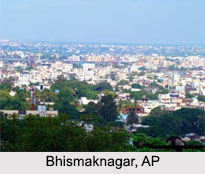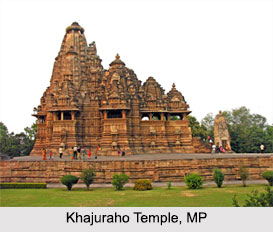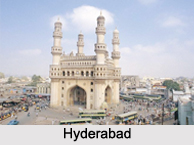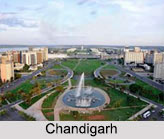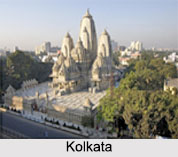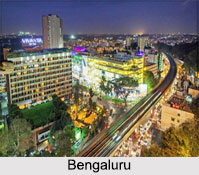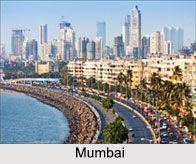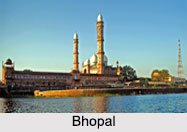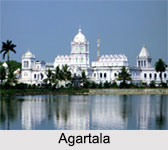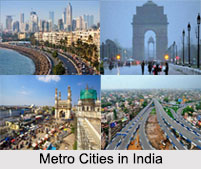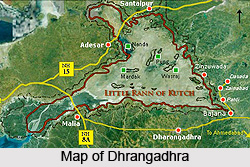 Dhrangadhra, located in the Surendranagar district of the Indian state Gujarat, is a city and municipality. The place derives its name from Sanskrit words `dhrang` which refers to stone and `dhara` which means earth. It is believed that the city has been so named owing to the presence of strong and widespread black stone bedrock just under the soil. It lies at an altitude of 64 metres. Dhrangadhra served as the capital of Dhrangadhra state which was one of the eight first class princely states of the Kathiawar Agency in the Bombay Presidency during the British Raj. Dhrangadhra hosts a secular population comprising Hindus, Muslims, Zoroastrians and Jains. Dhrangadhra also serves as the headquarters of the Deputy Conservator of Forests. Falku River meanders through the city. Several Gujarati writers like novelist-author Mr. Atulkumar Vyas, poet late Mr. Ramesh Nimbark, poet Mr. Kanaiyalal Bhatt and others belong to this city.
Dhrangadhra, located in the Surendranagar district of the Indian state Gujarat, is a city and municipality. The place derives its name from Sanskrit words `dhrang` which refers to stone and `dhara` which means earth. It is believed that the city has been so named owing to the presence of strong and widespread black stone bedrock just under the soil. It lies at an altitude of 64 metres. Dhrangadhra served as the capital of Dhrangadhra state which was one of the eight first class princely states of the Kathiawar Agency in the Bombay Presidency during the British Raj. Dhrangadhra hosts a secular population comprising Hindus, Muslims, Zoroastrians and Jains. Dhrangadhra also serves as the headquarters of the Deputy Conservator of Forests. Falku River meanders through the city. Several Gujarati writers like novelist-author Mr. Atulkumar Vyas, poet late Mr. Ramesh Nimbark, poet Mr. Kanaiyalal Bhatt and others belong to this city.
History of Dhrangadhra
The history of Dhrangadhra dates back to Lower Paleolithic Period. It was formed from Jhalawar State. The latter was established around 1090 AD and was ruled by the Patel. Dhrangadhra became its capital in 1735 AD. Following this, the state was renamed as Dhrangadhra-Halvad state. In the year 1941 the population of the princely state of Dhrangadhra was recorded to be 94417 and encompassed an area of 1167 square miles. The state of Dhrangadhra was included in the Jhalawar district in Saurashtra in 1948. Later in 1956 it was made a part of Gujarat.
Economy of Dhrangadhra
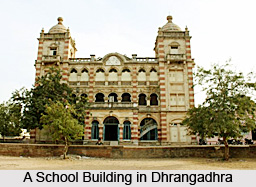 Majority of the people of Dhrangadhra depend on farming and shop keeping. Cotton and Salt traders are affluent here since 300 years. Industries producing chemical products, spices, food products, pickles of various flavours and many more stand here. Dhrangadhra also hosts the Gobar Gas Plant. A number of hospitals, colleges and schools are also there. Bharwad and Rabari are the two farming communities dwelling in the surrounding villages which make their living by raising camels, goats, sheep and cattle. In the summers, a camp of snake charmers is hosted in the outskirts of the city. In the year 1925 the first soda ash factory of India was established.
Majority of the people of Dhrangadhra depend on farming and shop keeping. Cotton and Salt traders are affluent here since 300 years. Industries producing chemical products, spices, food products, pickles of various flavours and many more stand here. Dhrangadhra also hosts the Gobar Gas Plant. A number of hospitals, colleges and schools are also there. Bharwad and Rabari are the two farming communities dwelling in the surrounding villages which make their living by raising camels, goats, sheep and cattle. In the summers, a camp of snake charmers is hosted in the outskirts of the city. In the year 1925 the first soda ash factory of India was established.
Art and Culture of Dhrangadhra
Dhrangadhra houses many architectural wonders which showcase the influences of the local medieval history. The city boasts several temples, palaces and mosques belonging to various historical eras. Many places of worships and monuments boasting the ancient art and craft traditions including embroidery, tie and dye fabrics, jewellery making, stone sculpture etc. Dargah of Mohahmad Musa and Raj Darabar are the famous monuments of Dhrangadhra. Stone artwork of the city is quite prominent. Sompura caste dwelling in Dhrangadhra is known to have constructed a number of Jain Derasars which refers to a sort of Jain temple which can be spotted all over Gujarat and India. The temple of Somnath has been constructed by the people of Sompura caste living in Dhrangadhra. Several sites belonging to the Harappan Period are also spread along the city. Deshal Bhagat temple stands outside the city. Other prominent temples around the city enlist Shakti Ma Temple, Jalaram Bapa Temple, Dariyalal Temple, Bala Hanumanji Temple, Rokadiya Hanumanji Temple, Fuleshwar Mahadev Temple, Bhala Hanumaan Mandir, Ashram of Valbai Maa etc.
